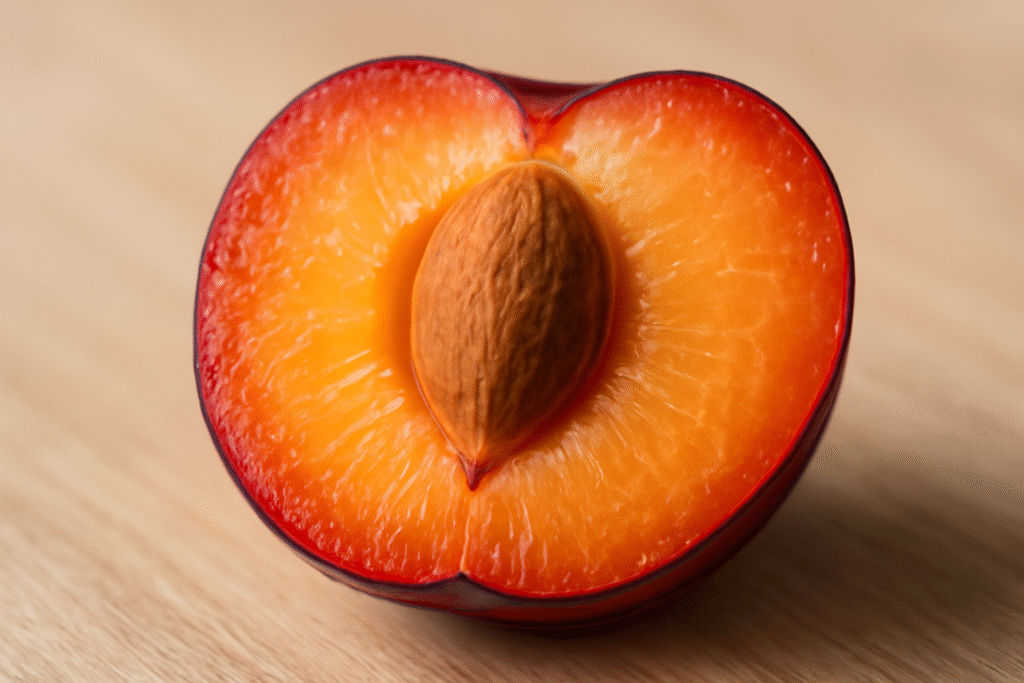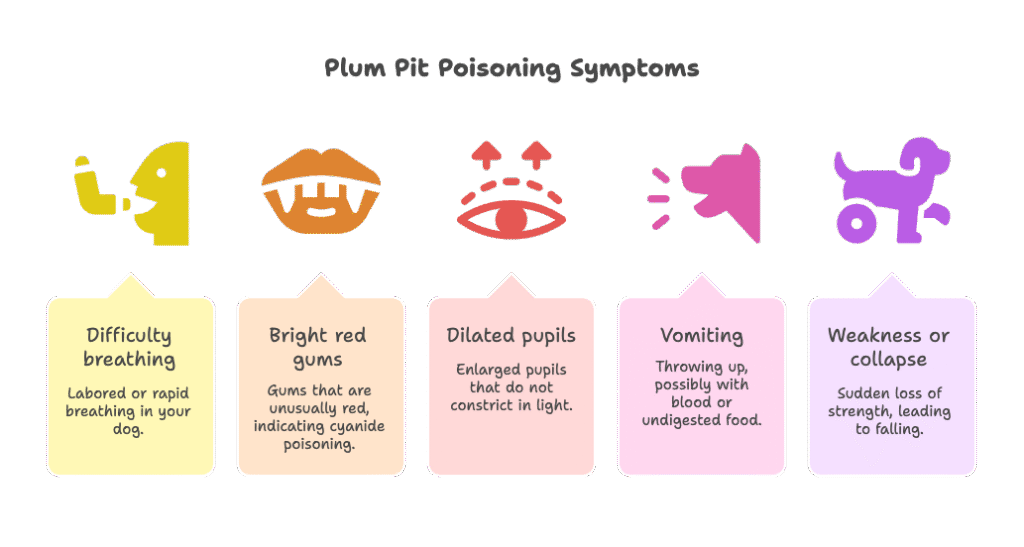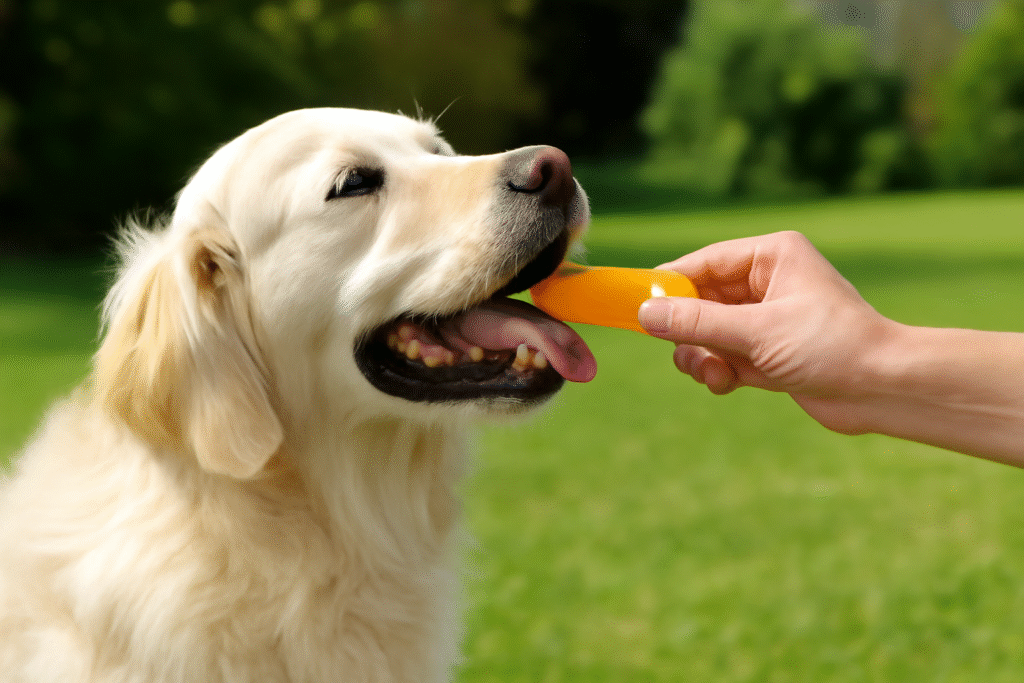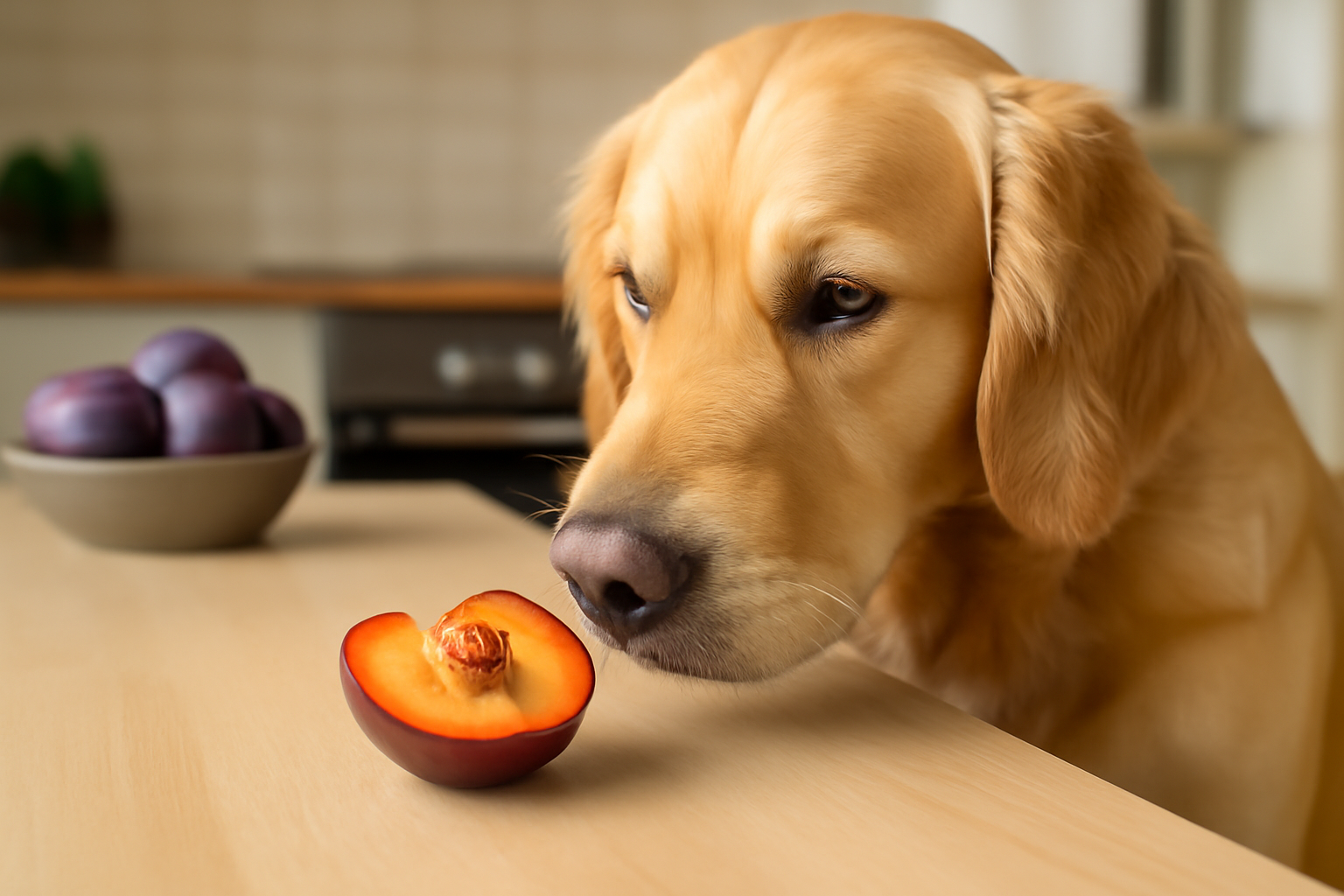Medical Disclaimer: This content is for informational purposes only and does not replace professional veterinary advice. Always consult your veterinarian before introducing new foods to your pet’s diet.
Table of Contents
Introduction
It’s a warm summer afternoon, and you’re enjoying a juicy plum when your dog trots over, tail wagging and eyes wide with curiosity. It’s tempting to share, but you pause—can dogs eat plums safely? As a veterinarian, I’ve had countless pet parents ask this very question. The answer isn’t a simple yes or no, and that’s exactly why this guide matters. With the right precautions, your dog can eat plums, but knowing which parts are safe—and which are dangerous—can be the difference between a sweet treat and a veterinary emergency.
🐾 Key Takeaways: Can Dogs Eat Plums?
- Yes—but only the flesh: Dogs can eat plums in moderation if the pit, stem, and leaves are completely removed.
- The pit is dangerous: It contains amygdalin, which can release cyanide when chewed or digested (Merck Vet Manual).
- Overfeeding causes tummy trouble: Too much fruit sugar can lead to vomiting, diarrhea, and gas.
- Start small: If your dog’s never tried plums, introduce a tiny amount and monitor for signs of upset.
- When in doubt, call your vet: Swallowed or chewed pits can be an emergency (Pet Poison Helpline).
Are Plums Safe for Dogs?
When asked can dogs eat plums, the safest answer is: yes, but only parts of it—and only in moderation. While the juicy flesh can be an occasional sweet snack, other components of the plum are risky and sometimes toxic.
What’s Okay to Eat
✅ Ripe Plum Flesh
This is the only part dogs can eat safely—and even then, only in small amounts. The fruit’s flesh contains:
- Vitamin C and vitamin K for immune support and blood clotting
- Fibre, which supports healthy digestion
- Antioxidants, like anthocyanins, which may help reduce inflammation (Petfoodology, Tufts)
For many dogs, a few small slices of fresh, ripe plum can be a tasty enrichment treat. But always remove everything else first.

What’s Dangerous and Why
🚫 Plum Pits
This is where the real danger lies. Plum pits contain amygdalin, a compound that converts into cyanide when chewed or digested (Merck Vet Manual).
Health hazards include:
- Cyanide poisoning
- Choking hazard
- Intestinal blockage, especially in small dogs
🚫 Stems and Leaves
Like pits, these plant parts also contain cyanogenic compounds and should never be ingested (ASPCA).
If your dog eats a whole plum, especially if the pit is broken, you should treat it as a potential emergency.
Cyanide Risk from Plum Pits
The question can dogs eat plums becomes more complex once you consider what’s hiding inside the fruit. The pit—often overlooked—poses the most serious threat.
To learn more about the fact that dogs can consume avocados, please refer to the following link:
How Cyanide Affects Dogs
Plum pits contain amygdalin, a cyanogenic glycoside that releases hydrogen cyanide during digestion. Cyanide interferes with cellular oxygen uptake, making it incredibly toxic, even in small amounts.
According to the Pet Poison Helpline, it takes only one chewed pit to cause severe symptoms in smaller breeds. If a dog swallows the pit whole, the risk shifts from toxicity to obstruction—still dangerous but for different reasons.
Symptoms to Watch For
If your dog ate a plum pit, especially if it was cracked or chewed, watch closely for:
- 🫁 Difficulty breathing
- 💉 Bright red gums
- 😵💫 Dilated pupils
- 🤢 Vomiting
- 🐾 Weakness or sudden collapse
These signs can appear within 15–60 minutes and require immediate veterinary care. Cyanide poisoning progresses rapidly, so don’t wait.
Veterinary resources like the Merck Veterinary Manual emphasize the need for urgent intervention when cyanide exposure is suspected.

Digestive Side Effects from Plum Flesh
Even when you remove the pit, some pet owners still wonder: can dogs eat plums without getting sick? The answer depends on how much they eat and their individual sensitivity.
Why Plum Flesh Can Upset Your Dog’s Stomach
Plum flesh is high in natural sugars and soluble fibre. While these are generally harmless in moderation, too much can overwhelm your dog’s digestive system—especially if they’re not used to fruit.
Common issues include:
- Vomiting – Dogs don’t digest fructose as efficiently as humans
- Diarrhea – A sudden fibre load can loosen stools
- Flatulence or abdominal discomfort – Especially in small breeds or sensitive stomachs
According to Tufts University’s Petfoodology, dogs don’t need fruit in their diets, and too much can cause more harm than good.
If your dog is diabetic, even a small portion of plum flesh could spike their blood sugar—so always check with your vet first.
How to Safely Share Plums with Your Dog
If you’re still asking yourself, can dogs eat plums safely, the key lies in careful preparation and portion control. Here’s how to turn a risky fruit into a safe treat.
Vet-Approved Guidelines
✔ Only serve ripe, washed plum flesh – Discard any parts that are under- or overripe, and always wash thoroughly to remove pesticide residues.
✔ Remove the pit, stem, and leaves completely – This step is non-negotiable. Even a small amount of pit residue can be dangerous.
✔ Start with tiny portions – A teaspoon-sized piece is plenty for a small dog; larger dogs can have a few more bites. Always monitor for any digestive upset afterward.
✔ Limit to occasional treats – Once a week is more than enough. Remember, dogs do not require fruit in their diet (CVMA).
✔ Cut into bite-sized pieces – This helps prevent choking and makes it easier to portion.

What to Avoid Completely
❌ Never offer a whole plum – Even if your dog is a “gentle chewer,” the pit still poses a danger.
❌ Avoid dried plums (prunes) – They’re high in sugar and fibre, which can trigger diarrhea and gas.
❌ Don’t feed unripe plums – These can be more acidic and harder to digest, increasing the risk of gastrointestinal irritation.
❌ Keep plums out of reach – Dogs are curious and fast. Store plums in closed containers or refrigerator drawers.
Following these precautions, your dog can eat plums safely—just not every day and never unsupervised.
What to Do If Your Dog Eats a Whole Plum
Despite our best efforts, dogs are opportunistic eaters. So what should you do if your dog suddenly grabs and swallows a whole plum? This is one of the most serious situations where the question can dogs eat plums shifts from curiosity to urgent action.

Step-by-Step Emergency Advice
Step 1: Stay calm but act fast
Try to determine whether your dog chewed the pit or swallowed it whole. A chewed pit is more dangerous due to cyanide release; a swallowed pit can still cause a life-threatening intestinal blockage.
Step 2: Monitor for symptoms
If the pit was chewed:
- Difficulty breathing
- Bright red gums
- Vomiting or drooling
- Weakness or collapse
If the pit was swallowed whole:
- Pawing at mouth
- Gagging or choking
- Bloating or signs of abdominal pain
- Straining or inability to defecate
Step 3: Contact your veterinarian immediately
Let them know exactly what happened. You may be asked to bring your dog in for:
- X-rays to check for obstruction
- Induced vomiting (only under medical supervision)
- Activated charcoal for toxin absorption
- Supportive care, including IV fluids and oxygen
Step 4: Prevent it from happening again
- Store plums in sealed containers
- Don’t leave fruit bowls where your dog can reach
- Educate family members on the risks (ASPCA)
Veterinary intervention is critical. One pit might not always cause harm—but when it does, minutes matter.
Alternatives to Plums That Are Dog-Safe
If you’re looking for fruity options that are both safe and easier to manage, you’re not alone. Many pet parents who ask can dogs eat plums are also curious about safer alternatives.
Vet-Approved Fruit Options
Here are some fruits that are safer and easier to serve than plums:
| Fruit | Safe for Dogs? | Preparation Tips |
| Blueberries | ✅ Yes | Serve fresh or frozen, in small amounts |
| Apples | ✅ Yes | Remove core and seeds before serving |
| Watermelon | ✅ Yes | Remove rind and seeds |
| Bananas | ✅ Yes | Peel and slice, watch sugar intake |
| Strawberries | ✅ Yes | Wash and slice, high in vitamin C |
According to Tufts Petfoodology, fruits like blueberries and apples are low in calories, high in antioxidants, and generally well-tolerated by most dogs.
Just like with plums, moderation is key. Use fruits as occasional training treats or meal toppers—not dietary staples.
FAQs About Dogs Eating Plums
❓Can plum pits kill dogs?
Yes, if chewed or broken open, plum pits can release cyanide—a lethal toxin that affects a dog’s ability to absorb oxygen. Even a single chewed pit can be fatal, especially for small dogs. If you suspect your dog has ingested a pit, contact your vet immediately or call the Pet Poison Helpline.
❓Is it okay if my dog licked a plum?
Generally, yes. If your dog only licked the plum flesh and didn’t ingest any of the pit, stem, or leaves, the risk is low. Still, monitor for signs of gastrointestinal upset, especially if it’s their first exposure to the fruit.
❓Can dogs eat prunes or dried plums?
No. Prunes are very high in sugar and fibre, which can cause diarrhea and stomach cramps. Some may also contain added preservatives that aren’t dog-safe.
❓What fruits are safest for dogs?
Safer alternatives include blueberries, apple slices (without seeds), bananas, and seedless watermelon. These fruits are easier to serve safely and offer similar nutritional benefits without the risks associated with stone fruits.
❓How long after eating a pit do symptoms appear?
Cyanide poisoning symptoms can show within 15 to 60 minutes of chewing or digesting a plum pit. Signs like drooling, red gums, or collapse should be treated as a veterinary emergency.
Final Verdict: Should You Feed Your Dog Plums?
So, can dogs eat plums safely? The answer is yes—but only under very strict conditions.
If you’re offering a small slice of ripe, pit-free plum as a rare treat, it’s generally safe. But the moment stems, leaves, or pits come into the picture, the risks multiply—from choking to cyanide poisoning.
✅ Do:
- Only offer small pieces of ripe plum flesh
- Remove pits, stems, and leaves completely
- Monitor for digestive upset after new foods
- Use plums as an occasional treat, not a staple
❌ Don’t:
- Let your dog near whole plums
- Give dried plums (prunes)
- Ignore signs of discomfort or poisoning
- Skip the vet if something seems wrong
As a veterinarian, I’ve seen dogs recover just fine after sneaking a bit of fruit—but I’ve also seen the consequences of a swallowed plum pit. If you’re ever unsure, stick to safer fruit options or call your vet for guidance.
Your dog can eat plums—but only if you prepare them properly and feed them wisely. 🐕🍑





Pingback: Can Dogs Eat Oranges? Vet Guide to Safety 101